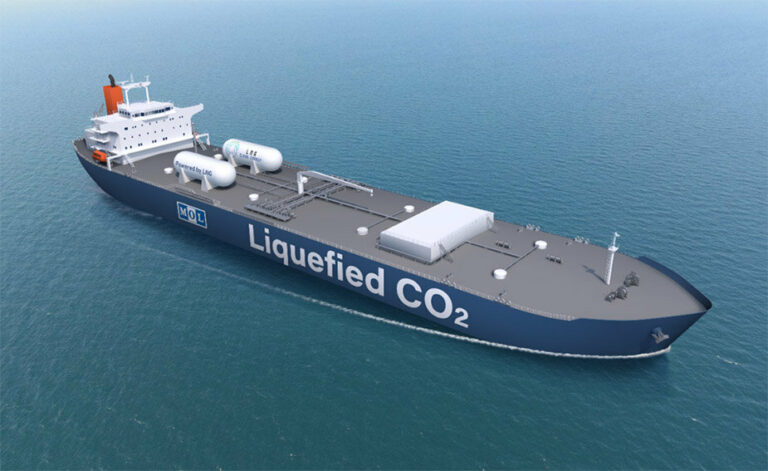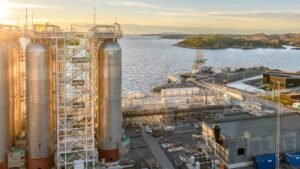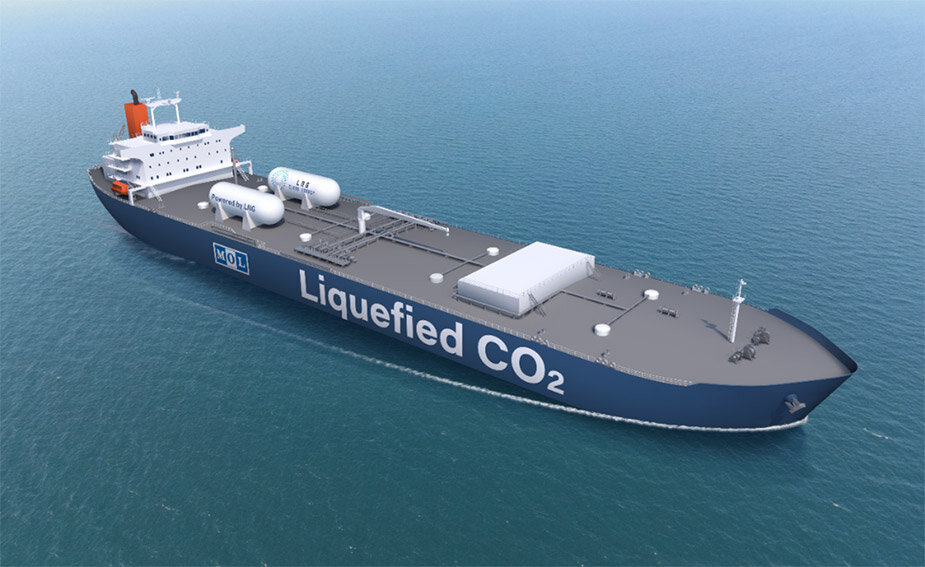Interview: Almost every ocean-going ship type can become a CO2 carrier
Home Green Marine Interview: Almost every ocean-going ship type can become a CO2 carrier
In the ever-evolving landscape of maritime innovation, one topic has emerged as a beacon of change and promise – carbon capture in shipping. As global efforts to decarbonize intensify, the role of CO2 capture, liquefaction, and transport is expected to grow in importance, especially in line with the anticipated demand surge.

CO2 transport serves as a linchpin connecting various sectors, offering a conduit to manage and repurpose carbon emissions generated from industrial processes and energy production.
It facilitates the capture of carbon dioxide emissions at the source, such as power plants and industrial facilities, redirecting them away from the atmosphere where they contribute to climate change. This captured CO2 is then transported to designated sites for storage, utilization, or even repurposing as a feedstock for green fuels—a process integral to the circular economy.
That being said, the market is at a very nascent stage of development with a small number of LCO2 carriers being built specifically for this purpose. Namely, Northern Lights, a JV between Shell, Equinor, and TotalEnergies, has ordered three vessels of this sort in China with several more projects in the books.
The company announced earlier this week its first binding commercial deal for CO2 transport and storage pacing the way for other companies to follow suit.
-

Posted: 1 day ago
However, the CO2 transport and storage market is faced with numerous challenges, ranging from technical complexities and regulatory uncertainties to the need for strategic alignment between industry stakeholders.
These uncertainties are seen as one of the biggest obstacles to greater investment in vessels able to carry this precious cargo, together with finding sufficient financing to build the ships.
Nevertheless, the low number of orders might actually be a blessing in disguise for existing ships as demand for liquified CO2 promises to surge.

In a candid conversation with Offshore Energy, Sean McLaughlin, Strategic Consultant at Houlder, provided valuable insights into the current state of the CO2 shipping market and the challenges and opportunities that lie ahead as the industry embarks on a journey through the uncharted waters of this transformative sector.
Houlder specializes in engineering design, clean technology, and technical consultancy for marine and offshore environments. The company recently completed a major design project for Shell involving the development of a concept design for a 20,000m3 liquid hydrogen (LH2) carrier. It has also worked as a consultant on studies involving carbon capture, dual-fuel vessel designs, and wind-assist technology, among numerous others.
“As onboard carbon capture gains traction, almost every ocean-going ship type has the potential to become a CO2 carrier. If this potential additional fleet is used, it can significantly bridge the gap between supply and demand for CO2 shipping,” says McLaughlin.
“However, this also brings challenges in accommodating this new cargo into the scope of many more ship owners; it’s not just those who plan to build dedicated CO2 carriers that need to be aware of the challenges.”
As explained, if those ships capture CO2 in a pure form that can then be introduced for reuse such as synthetic fuels then there is the opportunity for a closed loop. This would mean, for example, that a methanol-burning ship with onboard carbon capture has a bunkering handshake with its eMethanol provider delivering feedstock for its eMethanol production process.
“Looking strategically, we have all been used to seeing ships as a system, but we can no longer look at the ship system in isolation. The transportation of CO2 presents a clear example of why we need to see the ship as part of the whole logistics and value chain and make sure it fits in the most effective way.”
“Rising to the strategic challenges will require new paradigms and radical new ways of operating, rather than the gradual evolution that shipping has previously been used to.”
A fresh look at vessel designs and CO2 re-use opportunities
The CO2 shipping industry is on the cusp of a transformative era marked by varied distances, cargo sizes, end destinations, and an increasingly diverse range of cargo sources.
Market estimates indicate that there will be a rapidly growing demand for CO2 shipping based on the global map of the CCS projects and the sheer realization that the hard-to-abate sector would have to turn to CCS to cut their emissions in line with Paris Agreement targets.
The surge in demand to transport substantial volumes of CO2 adds complexity to the market, presenting challenges for both newcomers and established players.
Navigating this evolving landscape requires a concerted effort to dismantle technical and operational barriers, ensuring that the CO2 shipping sector can effectively cater to current needs and anticipated future demand.
“Forecasts for growth in demand for CO2 shipping have been largely predicated on the growing network of sequestration routes for CO2 captured from industrial processes. The potential for significantly increased re-use opportunities such as e-fuels could also drive long-distance CO2 shipping to manufacturing hubs,” McLaughlin said.
An interesting trend is emerging, McLaughlin further explains, which is the need for captured CO2 to produce some green, synthetic e-fuels – specifically e-methanol and e-methane (e-LNG).
“Both of these are seen by many as practical, lower-risk, and lower-cost alternative marine fuels in comparison to e-ammonia and e-hydrogen. Therefore, setting up the CO2 shipping backbone to produce them will be important to the shipping industry’s decarbonization efforts,” he adds.
“The growth in re-use opportunities such as this will also give rise to a potential for new routes and potentially different CO2 carrier designs. More specifically, this new large-scale and more diverse cargo requires a fresh and potentially radical look at vessel and containment designs. Houlder has seen several tenders for CO2 carrier designs that fail to recognize the number of variables and rely on a repeat of previous designs for key areas such as cargo containment,” McLaughlin pointed out.
Common misconceptions about CO2 transport
When asked about some common misconceptions or oversights in the CO2 shipping sector, and how can these be avoided to prevent unnecessary CAPEX or operational constraints, McLaughlin explained that it must be more widely understood that not all CO2 is the same.
“There are different levels of CO2 purity which impact vessel equipment and onshore infrastructure investments,” he pointed out.
These misconceptions could result in significant over-specification of storage tanks, reliquefication plants, and other equipment, potentially resulting in unnecessary CAPEX or constraints in the vessels operating environment.
There is also the potential of a baked-in OPEX problem, as noted by McLaughlin, resulting from significant and potentially unnecessary increases in non-revenue earning cargo weight and energy consumption in maintaining it.
Speaking on the technical considerations related to CO2 purity in shipping and how it impacts vessel equipment and onshore infrastructure decisions, McLaughlin stressed that the purity of CO2 will be dictated by the method of its capture, the source of the CO2 (e.g. exhaust gases or an industrial or chemical process) and any post-capture clean-up process associated with liquefication.
“A wide range of capture technologies are ultimately likely to be used and some technologies even result in CO2 being stored within other materials rather than as a gas or a liquid. This all adds further complexity to vessel equipment decisions,” he went on to say.
“It’s not just a percentage game as the nature of the impurity is often as relevant as its quantity. The level and type of impurity may impact corrosion levels in the containment tanks, in the loading and unloading equipment, or it may increase safety hazards in case of an escape. The presence of other impurities such as nitrogen, argon, hydrogen or methane also affect the storage pressure necessary for the liquid at a given temperature. Therefore, CO2 impurities will impact on the onboard containment equipment specifications.”
There are also operational variables that ship owners must be aware of and address, such as the use or the requirements of a designated sequestration destination which impacts the CO2 purity requirements, and on board equipment specifications.
Given these preconditions, McLaughlin insists that alignment between CO2 shipping and shore-based infrastructure development is key.
Regulatory framework
Looking at the existing and potential future regulatory frameworks that impact CO2 shipping, and the key compliance considerations for companies in this sector, it is evident that CO2 shipping regulations are still in the early stages of development.
McLaughlin believes that building a robust regulatory framework and rigorous standards to create a level playing field for this burgeoning industry would pave the way for investment and development of key infrastructure.
“It’s not just about the regulators. The purity challenge means that there is going to be a need for certification of cargo so that the Master knows what he is loading and how it is going to need to be handled on the voyage,” he said, stressing that there is no place for binary or blanket regulations
“CO2 shipping requires a tailored set of legislation and standards. With specific rules for CO2 carriers in development, class societies will play a pivotal role.”
-

Posted: 3 months ago
Enter EU ETS and FuelEU Maritime
With the introduction of EU ETS and FuelEU Maritime, the EU regulatory system has designed a comprehensive framework for the decarbonization of shipping, laying the groundwork for regulating CCS as well.
“There is work to be done before both EU ETS and FuelEU Maritime will support the positive impact of onboard carbon capture when measuring emissions. In one, it’s about defining the process and in the other it’s about including it as a measure,” he said.
As explained, both EU ETS and FuelEU Maritime should allow this well before 2030, potentially on a timeline that will be aligned with the availability of the technology. Giving credit for this emission abatement measure will certainly support an expansion of its adoption and in turn, add significantly to the quantities of CO2 that need to be moved either to sequestration or re-use.
This will mean the owners of ships dedicated to CO2 cargoes and those who carry it as a consequence of onboard capture will need to understand the cargo better.
In a market with evolving carbon pricing mechanisms, Offshore Energy asked how can companies assess the impact of carbon pricing on their profitability and investment decisions.
Are there specific strategies or practices that can help companies adapt to changing carbon pricing scenarios in CO2 shipping?
“Both FuelEU Maritime and the EU ETS have the potential to add significantly to the OPEX of ships without onboard capture. In their recent study, a modest assumption on the reduction in EU ETS-related costs was the primary driver in DNV’s assessment that on-board carbon capture could be financially viable,” he said.
“The sort of techno-economic study carried out on an imaginary vessel and included in the recent DNV future fuels report can be carried out on today’s fleet and as part of a new build assessment. The IMO, the EU, and other large global regulators are now setting out pathways for regulations such as CII, EU ETS, and FuelEU Maritime. These all allow for a model to be produced to show the likely financial and carbon payback of different clean technologies and design changes. It’s something that Houlder is increasingly becoming involved in.”
It’s time to get on with it!
The intertwining of profitability and decarbonization is not just a choice but a strategic imperative for the maritime industry. As ships navigate the seas of sustainable practices, it’s evident that their earnings potential will be intricately linked to their Environmental, Social, and Governance (ESG) performance. Balancing profitability with decarbonization is no longer a mere consideration but a fundamental aspect of the maritime sector’s evolution.
“In a nutshell, GHG emissions are now part of the OPEX model. They directly and indirectly drive a vessel’s earning capacity and that earning capacity links straight through to the vessel value on the balance sheet and to the cost of the money needed to fund it. This is now part of ‘business as usual’ and the cost of emissions is only going to increase in importance. It can’t be ignored or seen as a side issue,” McLaughlin stressed.
The fact of the matter is that CO2 is going to be part of the shipping industry and countless other industries’ challenges well into the future as fossil fuels are not going anywhere anytime soon.
“There isn’t a realistic option that sees fossil fuels disappear from our energy infrastructure in the next ten to fifteen years and the challenge for shipping is perhaps even bigger. All of the zero-carbon fuels rely on access to zero-carbon electricity to produce them. That’s also in short supply now and demand is growing exponentially. As Martin Stopford recently remarked; by comparison to other industries, such as land-based energy industries, shipping is tiny and the chances of shipping getting all the zero-carbon fuel it needs are very small,” he added.
“All of this means that finding ways of cleaning up the ships that are in the water today is the only way forward and for industry as a whole there is going to be a need to capture and dispose of the CO2 that will continue to be emitted. Shipping is going to be part of the logistics chain for doing that – it’s an opportunity that should be embraced.“
“The costs of not complying with decarbonization regulations will only increase and the cost of carbon will only increase. University College London (UCL) estimates that every year of inaction this decade will add an extra $100bn to the cost of shipping’s decarbonization. It’s time to get on with it!”
______________________________________________________________________________________________________
This is a free premium article to give you a sample of what Offshore Energy has to offer as part of our premium section. You can upgrade to premium access here.
